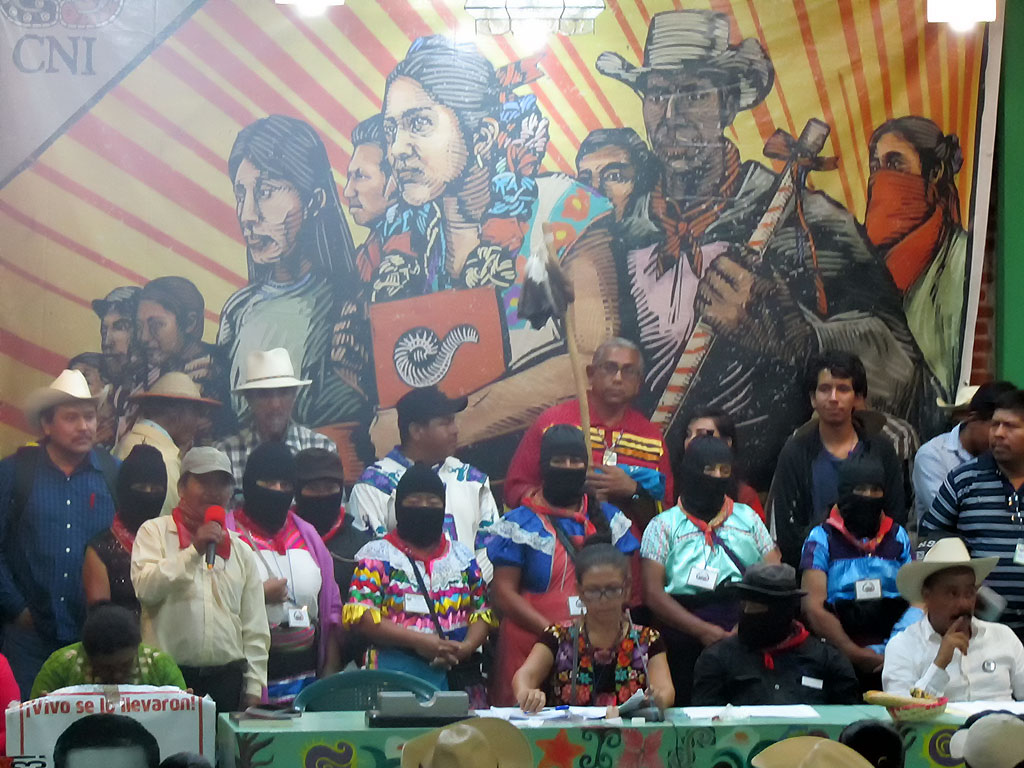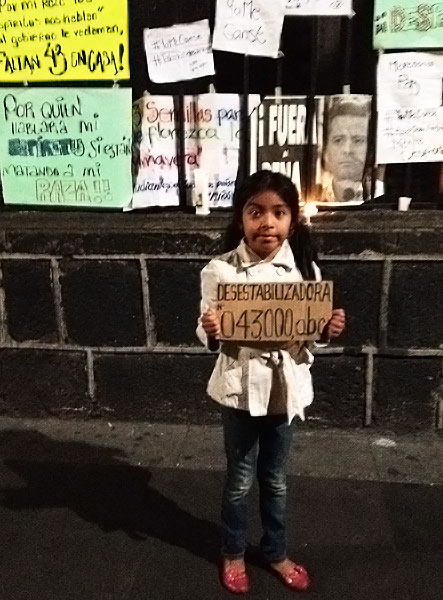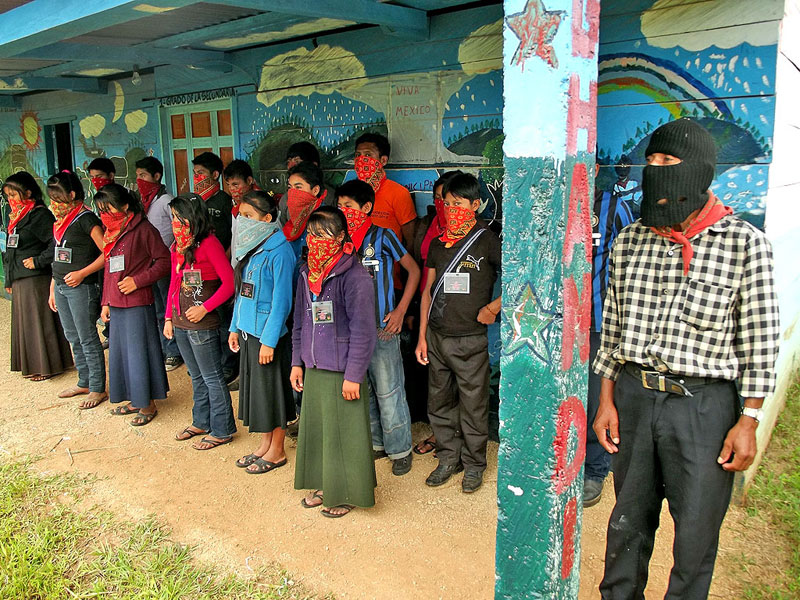2015
29/04/2017
LATEST: Mexico – Pressure from US and Human Rights Crises
27/06/2017December marked a decade since the beginning of the war against crime launched by ex-President Felipe Calderon Hinojosa (2006-2012) with an alarming toll: 186,000 dead, more than 28,000 disappeared (which increases to a rate of 11 disappearances per day, according to the Miguel Agustín Pro Juárez Human Rights Center, Centro Pro DH), and tens of thousands of displaced persons, a balance comparable to that of Central American armed conflicts in the 1980s. Over one billion pesos have been spent without reducing insecurity, harassment of civilians, and has implied a significant increase in human rights violations. Furthermore, domestic drug use has increased and, although some capos (cartel leaders) have been arrested, nine organized crime cartels and 37 criminal cells continue to operate. Civil organizations have concluded that, “the tightening of security measures has not, and will not, reduce violence in the country. Today we live in a much more insecure country, with weaker institutions and a criminal justice system that does not work.”
One of the most questioned sectors in this strategy has been the Army, which (outside its constitutional mandate) has been deployed to carry out security tasks. In December, the Secretary of National Defense, General Salvador Cienfuegos Zepeda, was straightforward: “The military does not study to prosecute criminals.” And in the absence of a legal framework, “they are already thinking through whether they wish to continue to confront these groups, at the risk of being prosecuted for a crime related to human rights.” He said: “We are carrying out functions that do not correspond to us, all because there is no one to do them or they are unqualified to do so.” Enrique Peña Nieto later said that the military will continue in the streets “while we achieve the objective of this subject still pending (…) to have a country in conditions of greater peace and tranquility.”
Around these same dates, an initiative for a new Internal Security Law, which seeks to normalize military participation in public security tasks, was presented. Centro Pro DH questions whether “instead of seriously undertaking the design of a program for the gradual withdrawal of the security forces, as proposed by international mechanisms in this area, the idea of generating an ad-hoc legal framework for the Army and Navy, normalizing the state of emergency, is revived.”
Moreover, in its report “The Roads of Resistance”, the Human Rights Center Fray Bartolomé de Las Casas (CDHFBC) affirmed that the internal armed conflict in Chiapas was still in force in these terms: “Firstly, there are no peace agreements and the authorities have never responded to the demands of the EZLN; Secondly, because the Mexican state, by action or omission, maintains an aggressive policy and a counterinsurgency strategy that are implemented by the different levels of government. The co-optation of peasant, indigenous, and social organizations persists, through subsidized programs and governmental projects so as to control the population and territories for political and electoral reasons. The weakening of the social fabric in communities and peoples also continues in various ways (…); And the initiatives of organizations are criminalized “. On the other hand, the CDHFBC argued that “the resistance and efforts to build alternatives on the part of the communities and the Zapatistas support bases, their initiatives, continue to summon other people, intellectuals, activists and independent organizations from around the world. “
However, in this same report, the CDHFBC stated that counterinsurgency actions go beyond the EZLN and “are now complemented by a broader spectrum of warfare strategies“. It cited as an example the teachers’ movement that opposed the education reform approved in 2013. The teachers maintained a 4-month strike facing a context of escalating repressive violence that culminated in Nochixtlan, Oaxaca, leaving a record of 8 dead and dozens wounded and arrested. Human rights organizations denounced the indiscriminate use of public force, the increase in media campaigns of defamation and criminalization of the teachers, and the arbitrary arrests of at least 75 people, among those several leaders of the teachers’ movement.
Another source of political and social conflict: According to Proceso magazine, there are more than 250 social conflicts across the country most of which are linked to the National Infrastructure Plan (NIP) (2013). The NIP plans the construction of mega-projects and hundreds of other public works such as 16 new gas pipelines, 21 electricity projects, wind farms, and hydro and thermal power stations. In opposition to these plans, at least 52 social and community movements whose protagonists suffer recurrent repression and aggression. The Urgent Action for Human Rights Defenders, considered that these form part of a “strategy of social control of the population.”
This context led to an increase in forced displacement, as the CDHFBC pointed out in a December 2016 bulletin: “To the already historical figures of the forced displacement of communities that from 1994-2000 could not return to their territories because of threats from paramilitary groups; hundreds of displaced are added in a new context of war, of the violence of factional powers that in the coexistence of governments, companies and organized crime are destroying the life of the peoples and community in general, wrecking the social fabric, having as a final aim territorial control, and dispossession as well as the elimination of the autonomous organization of indigenous peoples.”
The issue of Land, Territory, and Natural Resources was confirmed as one of the most important in the defense strategies of the indigenous and campesino peoples: in November, after a 12-day walk through 11 municipalities in the North, Jungle, and Highlands regions, thousands of pilgrims arrived in San Cristobal de Las Casas, where they denounced the insecurity they experience in their communities. They belong to the Movement in Defense of Life and Territory (MODEVITE), “composed of 10 parishes from 11 municipalities and 1 ejido” whose objective is “to organize and encourage the indigenous peoples of the area to build our autonomy as indigenous peoples and defend our Mother Earth.
Once again, with regard to political and social conflicts, since the last municipal elections, the victory of the Green Ecologist Party (PVEM) has unleashed several conflicts in areas formerly dominated by the Institutional Revolutionary Party (PRI) such as Chamula, Oxchuc, Chanal,and Chenalhó.
In October, in the context of the 20th anniversary of the National Indigenous Congress (CNI), the Fifth National Indigenous Congress was held in San Cristobal de Las Casas. At the end of the event, the CNI and the EZLN published the communiqué “May the Earth Tremble at its Core” (paraphrasing the national anthem), in which they denounced 27 grievances that indigenous peoples face in the country. What caused the biggest stir was the announcement of the beginning of a consultation with its support bases to see the convenience of naming an indigenous council of government and to invite an indigenous woman to represent them in the presidential elections of 2018.
In November, 33 years after its foundation, the EZLN clarified that “the CNI is who will decide whether or not to participate with one of their own delegates, and in that case, it can count on the support of Zapatismo “.But, “No, neither the EZLN as an organization nor any of its members will run for a “popularly elected office” in the 2018 elections. No, the EZLN will not become a political party. No, the EZLN will not present an indigenous Zapatista woman as a candidate for the presidency (…). No, the EZLN has not “altered its course” to any degree, nor has it reoriented its struggle to the institutional electoral path.”
In December, the CNI and the EZLN confirmed the decision to go on with their proposal which had been consulted in 525 communities of 43 indigenous peoples in 25 Mexican states. 430 of them had approved it.





